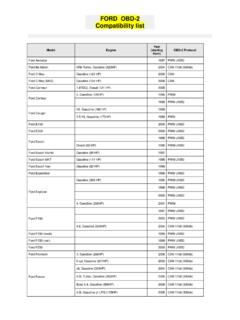Transcription of Operating Manual OBD Link Connector - AECS
1 Phone: +64 6 874 9077 Page 1 AECS OBD link Connector Operating Manual OBD link Connector OBD link Connector with handy torch in Connector plug 1. TEST OBD2 PORT BEFORE PLUG IN SCANTOOL It performs tests on all the 16 pins of OBD2 port for abnormality caused by shorting, reverse polarity, etc to avoid damage to your scan tool prior plugged in. 2. MONITOR VOLTAGE DURING REFLASH PROGRAMMING To monitor the OBD2 port power output in order to function properly during ECU programming, adaptation or flashing 3. DETECT COMMUNICATION PROTOCOL To detect which type of communication protocol the ECU is using, whether PWM (J1850), VPW (J1850), ISO 9141-2, DIS/ISO 14230-4 or Canbus (J-2284). 4. AS BREAK OUT BOX To provide easy access to any of the 16pins from the OBD2 DLC port for gathering of signal pulses when diagnosing with an oscilloscope, for data logging when used with a Y-cable, easy activation of blink codes, adjustment of idling rpm,etc 5.
2 CHECK ALTERNATOR CONDITION To have a quick Alternator charging check during idling and high RPM conditions. 6. AS DATA SAVER WHILE REPLACING CAR BATTERY As Power Backup for ECU (for saving data) when connected to an external 12V battery while replacing the weak car battery. 7. AS DC POWER SOURCE FOR OTHER DEVICES As Power source for other DC loads up to 5 Amps DC output at pin 4 (Ground) and pin16 (+) socket. Back to index Page 2 Please Note: Prices are subject to change without notice. AECS OBD link Connector HOW TO: 1. TEST OBD2 PORT BEFORE PLUG IN SCANTOOL Test is carried out with ignition key is OFF, ON and engine running Test without Ignition Key Connect the OBD BREAKOUT BOX to the OBD2 port on vehicle. The testing of the DLC port starts automatically as soon as OBD BREAKOUT BOX is plugged into it. This test is to check the condition of all pins before the ignition key is switched ON.
3 Volt Meter LED As soon as it powers up, the voltmeter will display voltage input. It will automatically check the following conditions: For 12V system: The alarm Beeping will trigger ON when the voltage falls below For 24V system: The alarm Beeping will trigger ON when the voltage falls below When the battery falls below for 12V system or for 24V system, the alarm will come on. In this case, you may need to start the engine to run for some time to charge the battery or replace with a new battery and then test again. 12V System < V 24V System < Action - Start engine - Recharge battery or replace battery Pins LED Testing of the 16 pins individually will also begin immediately with the following conditions To detect any voltage present on Car Manufacturer designated pins , 3, 8, 11, 12 & 13 (yellow colour socket) and OBD2 assigned protocol pins 2, 6, 7, 10, 14, 15 (blue colour socket), other than pins 4(Chassis), 5(Signal) for grounding (black colour socket) and pin 16 (red colour socket) which is positive supply 12V or 24V.
4 Back to index Phone: +64 6 874 9077 Page 3 When there is a presence of voltage (positive or negative) detected at a particular pin or other pins on the Manufacturer designated ones, the LED at the socket will blink in different ways. Depending on the voltage detected: OK / Caution LED a. If 12V or 24V is present the LED will blink slowly at interval of 1 sec between each blink. (The Caution Volt present LED stays ON). b. If under voltage < for 12V system or < for 24V system is present the LED will stays lighted up. (The Caution Volt present LED stays ON). Back to index Page 4 Please Note: Prices are subject to change without notice. If any of the above situations is encountered, do not plug in your Scan tool yet. Please check and compare the OBD2 circuit connection with vehicle Repair Manual for the reason of the shorting. This is because under normal circumstances when the ignition key is OFF, the ECU is also in the OFF state and there will be no communication signals or voltage output to the rest of the pins except pin 4 which is chassis ground and pin 16, the positive power output supplied from the battery direct.
5 With very remote chance unless the connections has been tempered, when OBD BREAKOUT BOX encounters that there is a reverse polarity occurred the green LEDs at pin 4 (Chassis) and pin 5 (Signal) ground will light up and turns into red colour. In this situation do not plug in the Scan tool. Check the source of the problem at the vehicle DLC and rectify it first before testing again. Test with ignition key in ON position. If the first test did not indicate any problem, then proceed with the second test. With the OBD BREAKOUT BOX still attached to the vehicle DLC, switch the ignition key to ON position then press Retest button on the OBD BREAKOUT BOX once Restart button AECS OBD link Connector Back to index Phone: +64 6 874 9077 Page 5 The test starts immediately with the testing of all the 14 pins other than pin 4 chassis ground and pin 16 positive Voltage supply. At the same time it will detect the type of communication protocol (PWM, VPW, ISO 9141-2, ISO 14230-4, CAN H, and CAN L) that the ECU is using and the blue LEDs will blink indicating the protocol currently being used.
6 If any voltage present on vehicle Manufacturer designated pins , 3, 8, 11, 12 & 13 (yellow colour socket) other than OBD2 assigned protocol pins 2, 6, 7, 10, 14, 15 (blue colour socket) and 5(Signal ground), the corresponding LED will light in the following manners. If 12V or 24V is present the LED will blink slowly at interval of 1 sec between each blink. (The Caution Volt present LED stays ON). If under voltage below for 12V system or for 24V system is present the LED will stays lighted up.. (The Caution Volt present LED stays ON). In situation where there is 12V or 24V present at the pin, the voltage was either supplied direct short or through a resistor. Its resistance value is normally not more than 20 for 12V system or 40 for 24V system. However, when a voltage 0V is supplied from the other end of the Scan tool to this pin, a current bigger than will flow. This indication serves as a warning when using Scan tool without current limiter built-in because this voltage may damage it when plugged in.
7 In many cases, Vehicle Manufacturers do provide some pins on the OBD2 Diagnostic link Connector (DLC) at the vehicle for RPM signals or Sensors signals used for testing or adjustment. These signals are usually found on any of the Manufacturer designated pins , 3, 8, 11, 12 &13 on the DLC. Therefore such signals will be detected and indicated as Caution Volt present . In other words, you can still plug in and use your scan tool but with risk in case where the Scan tool has no protection. It is also important to note that the presence of voltage in one of the pins maybe one of the reasons why sometimes communication failed between Scan tool and ECU because of the presence of the 12V or 24V shorting. However, almost all Scan tools nowadays come with protective current circuit and this indication should not be accepted as danger but served as a warning. Test with Engine running Back to index Page 6 AECS OBD link Connector When the second test has completed, proceed with the third and final test.
8 With the OBD BREAK-OUT BOX still attached to the vehicle DLC, start and keep the engine running. Press the Retest button on the OBD BREAKOUT BOX. The test starts and it will repeat as in the second test but this time it will test for over 15V or 29V presence while the engine is running. If the voltage is higher than for 12V system or for 24V system, the alarm will also come on. In this situation, the problem was caused by the regulator which had failed to regulate and cut OFF after reaching the preset charging voltage limit normally set below 15V. Also, if over for 12V system or for 24V system was detected at the input or any of the vehicle Manufacturer designated pins , 3, 8, 11, 12 & 13 (yellow colour socket) other than OBD2 assigned protocol pins 2, 6, 7, 10, 14, 15 (blue colour socket) the LED will blink at a very fast pace. (The Caution Volt present LED stays ON). In this case, do not plug and test with the Scan tool while engine running as this high voltage input may damage it.
9 Check the charging volts to determine whether the regulator is functioning properly. Under normal conditions when after all the testing of the vehicle DLC port has been done, where there are no abnormal activities, the green OK LED will light up. This indicates everything is OK and it is ready for Scan tool to be plugged in Back to index Page 7 2. MONITOR VOLTAGE DURING REFLASH PROGRAMMING It has voltage monitoring feature with Volts display which will give an alarm warning when the voltage falls below or higher than (for 12 V System) or below or higher than (for 24V system) while doing programming or coding. This feature will minimize any error while performing service reflashes. 3. DETECT COMMUNICATION PROTOCOL To monitor data stream and protocol being used when connecting the scan tool to the car OBD2 ports via OBD link Connector (OBD BREAKOUT BOX) LEDs Activities: OBD link Connector LEDs allows you to keep taps on power and ground.
10 It identifies the protocol used in the vehicle. 1. RED LEDs (Pin 16) - automatically turn-on as soon as you plugged into DLC. RED LEDs turn dim when: Low battery voltage - refer to Voltmeter and alarm will beep (below for 12V system and for 24V system). Wiring to DLC pin 16 is faulty. Grounds circuits have resistance issues. 2. GREEN LEDs (Pins 4 Chassis and 5 - Signal) - automatically turn-on as soon as you plugged into DLC. Ground LED (Pin 5) is connected to battery voltage via ECU. Therefore, a ground supply on pin 4 will not affect LED 5. A dim single green LED will indicate a circuit problem with the corresponding circuit. In remote case where if there is reverse polarity; the Green LED will turn into RED colour. When this happens, check the vehicle DLC Connector for wrong polarity. Rectify first and test again. 3. BLUE LEDs (Pins 2, 6, 7, 10, 14 and 15) - LEDs should flash when serial data voltage pulses are present in the data line.







